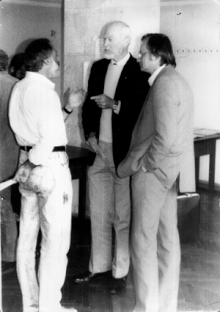Bryce DeWitt
Appearance
Bryce DeWitt | |
|---|---|
 Bryce with his wife Cécile | |
| Born | Carl Bryce Seligman January 8, 1923 Dinuba, California, U.S. |
| Died | September 23, 2004 (aged 81) Austin, Texas, U.S. |
| Alma mater | Harvard University (PhD) |
| Known for | |
| Spouse | |
| Children | 4 |
| Awards |
|
| Scientific career | |
| Fields | Theoretical physics |
| Institutions | |
| Doctoral advisor | Julian Schwinger |
| Doctoral students | |
École de Physique des Houches (Les Houches Physics School), 1972. From left, Yuval Ne'eman, Bryce DeWitt, Kip Thorne
.
Bryce Seligman DeWitt (born Carl Bryce Seligman; January 8, 1923 – September 23, 2004) was an American
gravitation and quantum field theory.[1]
Personal life
He was born Carl Bryce Seligman, but he and his three brothers, including the noted ichthyologist,
Cecile DeWitt-Morette, a mathematical physicist, accepted faculty positions at the University of Texas at Austin.[2] DeWitt trained in World War II as a naval aviator, but the war ended before he saw combat. He died September 23, 2004, from pancreatic cancer at the age of 81. He is buried in France, and was survived by his wife and four daughters.[3][1]
Academic life
He received his bachelor's (Lawrence Livermore Lab (1952-'55), and then held faculty positions at the University of North Carolina at Chapel Hill (1956-'72) and, later, the University of Texas at Austin (1973-2004). He was awarded the Dirac Prize in 1987,[4] the Pomeranchuk Prize in 2002, and the American Physical Society's Einstein Prize posthumously in 2005,[5] and was a member of the National Academy of Sciences.[6]
Work
He pioneered work in the quantization of
many-worlds interpretation of quantum mechanics.[1] With his student Larry Smarr, he originated the field of numerical relativity.[7]
: 25–35, 37
Books
- Bryce DeWitt, Dynamical theory of groups and fields, Gordon and Breach, New York, 1965
- Bryce DeWitt, ISBN 0-691-08131-X.
- S. M. Christensen, ed., Quantum theory of gravity. Essays in honor of the 60th birthday of Bryce S. DeWitt, Adam Hilger, Bristol, 1984.
- Bryce DeWitt, Supermanifolds, Cambridge University Press, Cambridge, 1985.
- Bryce DeWitt, The Global Approach to Quantum Field Theory, The International Series of Monographs on Physics, ISBN 978-0-19-851093-2.
- Bryce DeWitt, Sopra un raggio di luce, Di Renzo Editore, Roma, 2005.
- Bryce DeWitt, Bryce DeWitt's Lectures on Gravitation, Steven M. Christensen, ed., Springer, 2011.
References
- ^ a b c Weinberg, Steven (2008). "Bryce Seligman DeWitt 1923-2004: Biographical Memoir" (PDF). nasoline.org. Retrieved October 7, 2023.
- ^ "UTPhysicsHistorySite". Archived from the original on June 20, 2019.
- ^ Family Obituary
- ^ Dirac Prize citation, International Centre for Theoretical Physics
- ^ Einstein Prize citation, American Physical Society
- ^ "DeWitt, Bryce S. (Bryce Seligman), 1923-2004". history.aip.org. Retrieved October 7, 2023.
- ISBN 978-3-642-14270-3.
Further reading
- Deutsch, David; Isham, Christopher; Vilkovisky, Gregory (March 1, 2005). "Bryce Seligman DeWitt". Physics Today. 58 (3): 84–84. .
- DeWitt-Morette, Cécile (2011). The Pursuit of Quantum Gravity: Memoirs of Bryce DeWitt from 1946 to 2004. Springer. ISBN 978-3-642-14270-3.
- University of Texas obituary Archived May 11, 2008, at the Wayback Machine
- Oral history interview transcript with Bryce DeWitt and Cecile DeWitt-Morette on February 28 1995, American Institute of Physics, Niels Bohr Library & Archives
